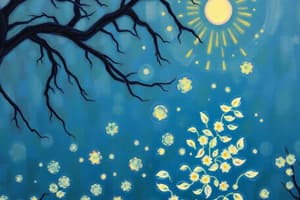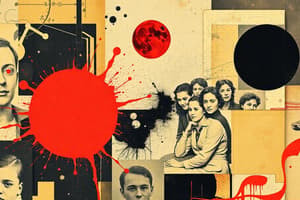Podcast
Questions and Answers
What are Group 7 elements also called?
What are Group 7 elements also called?
- Alkali metals
- Transition metals
- Halogens (correct)
- Noble gases
What are the physical states of halogens at room temperature?
What are the physical states of halogens at room temperature?
Chlorine is a gas, bromine is a liquid, iodine is a solid.
Which halogen is pale green in color?
Which halogen is pale green in color?
Chlorine
The melting and boiling points of halogens increase as you go down the group.
The melting and boiling points of halogens increase as you go down the group.
Which halogen is found at the top of Group 7 and has the lowest melting and boiling points?
Which halogen is found at the top of Group 7 and has the lowest melting and boiling points?
What happens to the colors of halogens as you go down the group?
What happens to the colors of halogens as you go down the group?
What is the trend in reactivity for Group 7 non-metals?
What is the trend in reactivity for Group 7 non-metals?
What occurs in a displacement reaction involving halogens?
What occurs in a displacement reaction involving halogens?
At room temperature, bromine is a ______.
At room temperature, bromine is a ______.
What is the electronic configuration of elements in Group 7?
What is the electronic configuration of elements in Group 7?
Flashcards
Halogens
Halogens
Group 7 elements, including Fluorine, Chlorine, Bromine, Iodine, and Astatine, are called halogens. They are all non-metals.
Diatomic Molecules
Diatomic Molecules
Halogens exist as diatomic molecules, meaning they consist of two atoms bonded together.
Halogen States at Room Temp
Halogen States at Room Temp
At room temperature, halogens can be gases, liquids, or solids. Chlorine is a gas, Bromine is a liquid, and Iodine is a solid.
Halogen Color Trends
Halogen Color Trends
Signup and view all the flashcards
Halogen Melting/Boiling Points
Halogen Melting/Boiling Points
Signup and view all the flashcards
Halogen Reactivity Trends
Halogen Reactivity Trends
Signup and view all the flashcards
Halogen Displacement
Halogen Displacement
Signup and view all the flashcards
Chlorine Displaces Bromine
Chlorine Displaces Bromine
Signup and view all the flashcards
Halogen Electronic Configuration
Halogen Electronic Configuration
Signup and view all the flashcards
Halogen Reactivity and Electron Shells
Halogen Reactivity and Electron Shells
Signup and view all the flashcards
Study Notes
Group 7 Overview
- Group 7 elements are called halogens, comprising non-metals including Fluorine, Chlorine, Bromine, Iodine, and Astatine.
- Halogens exist as diatomic molecules, meaning they consist of two atoms.
Physical States & Properties
- At room temperature (20 °C), physical states of halogens vary:
- Chlorine is a gas
- Bromine is a liquid
- Iodine is a solid
- Halogens display a trend in color:
- Fluorine is pale green
- Bromine is red-brown
- Iodine is black.
Melting and Boiling Points
- The melting and boiling points of halogens increase down the group.
- Fluorine at the top has the lowest melting and boiling points.
- Astatine at the bottom has the highest melting and boiling points.
Reactivity Trends
- Reactivity of halogens increases as you move up the group.
- Chlorine is the most reactive, while Iodine is the least reactive among Chlorine, Bromine, and Iodine.
Displacement Reactions
- More reactive halogens displace less reactive halogens in aqueous solutions of their halides.
- Example: Chlorine displaces bromine from potassium bromide solution, forming potassium chloride.
Aqueous Solutions
- When chlorine is added to a colorless potassium bromide solution, it turns orange due to bromine formation.
- Reaction:
- ( \text{Cl}_2 (aq) + 2 \text{KBr} (aq) \rightarrow 2 \text{KCl} (aq) + \text{Br}_2 (aq) )
Halogen vs. Halide Displacement
- Bromine can displace iodine from an aqueous solution of magnesium iodide.
- Reaction:
- ( \text{Br}_2 (l) + 2 \text{MgI} (aq) \rightarrow 2 \text{MgBr} (aq) + \text{I}_2 (aq/s) )
Electronic Configuration
- Halogens have seven electrons in their outer shell, requiring one more electron to achieve a full outer shell.
- As you ascend Group 7, the number of electron shells decreases, enhancing the attraction of the nucleus for the outer electrons, thus increasing reactivity.
Summary of Trends
- Physical properties (melting/boiling points, states, and colors) show distinct trends down the group.
- Reactivity trends reveal that halogens become more reactive as one moves up the group.
Studying That Suits You
Use AI to generate personalized quizzes and flashcards to suit your learning preferences.




